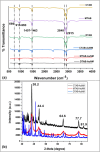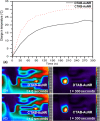Gold nanomakura: nanoarchitectonics and their photothermal response in association with carrageenan hydrogels
- PMID: 38887524
- PMCID: PMC11181249
- DOI: 10.3762/bjnano.15.56
Gold nanomakura: nanoarchitectonics and their photothermal response in association with carrageenan hydrogels
Abstract
Photothermal conversion of light into heat energy is an intrinsic optical property of metal nanoparticles when irradiated using near-infrared radiation. However, the impact of size and shape on the photothermal behaviour of gold nanomakura particles possessing optical absorption within 600-700 nm as well as on incorporation in hydrogels is not well reported. In this study, nanomakura-shaped anisotropic gold nanoparticles (AuNMs) were synthesized via a surfactant-assisted seed-mediated protocol. Quaternary cationic surfactants having variable carbon tail length (n = 16, 14, 12) were used as capping for tuning the plasmon peak of gold nanomakura within a 600-700 nm wavelength. The aspect ratio as well as anisotropy of synthesized gold nanomakura can influence photothermal response upon near-infrared irradiation. The role of carbon tail length was evident via absorption peaks obtained from longitudinal surface plasmon resonance analysis at 670, 650, and 630 nm in CTAB-AuNM, MTAB-AuNM, and DTAB-AuNM, respectively. Furthermore, the impact of morphology and surrounding milieu of the synthesized nanomakuras on photothermal conversion is investigated owing to their retention of plasmonic stability. Interestingly, we found that photothermal conversion was exclusively assigned to morphological features (i.e., nanoparticles of higher aspect ratio showed higher temperature change and vice versa irrespective of the surfactant used). To enable biofunctionality and stability, we used kappa-carrageenan- (k-CG) based hydrogels for incorporating the nanomakuras and further assessed their photothermal response. Nanomakura particles in association with k-CG were also able to show photothermal conversion, depicting their ability to interact with light without hindrance. The CTAB-AuNM, MTAB-AuNM, and DTAB-AuNM after incorporation into hydrogel beads attained up to ≈17.2, ≈17.2, and ≈15.7 °C, respectively. On the other hand, gold nanorods after incorporation into k-CG did not yield much photothermal response as compared to that of AuNMs. The results showed a promising platform to utilize nanomakura particles along with kappa-carrageenan hydrogels for enabling usage on nanophotonic, photothermal, and bio-imaging applications.
Keywords: anisotropy; hydrogel; kappa-carrageenan; metal nanoparticles; nanoarchitectonics; nanomakura; photothermal properties; surfactants.
Copyright © 2024, Das et al.
Figures











Similar articles
-
Calculated absorption and scattering properties of gold nanoparticles of different size, shape, and composition: applications in biological imaging and biomedicine.J Phys Chem B. 2006 Apr 13;110(14):7238-48. doi: 10.1021/jp057170o. J Phys Chem B. 2006. PMID: 16599493
-
Noble metals on the nanoscale: optical and photothermal properties and some applications in imaging, sensing, biology, and medicine.Acc Chem Res. 2008 Dec;41(12):1578-86. doi: 10.1021/ar7002804. Acc Chem Res. 2008. PMID: 18447366
-
Photothermal Conversion Profiling of Large-Scaled Synthesized Gold Nanorods Using Binary Surfactant with Hydroquinone as a Reducing Agent.Nanomaterials (Basel). 2022 May 18;12(10):1723. doi: 10.3390/nano12101723. Nanomaterials (Basel). 2022. PMID: 35630943 Free PMC article.
-
Gold Nanorod-Assisted Photothermal Therapy and Improvement Strategies.Bioengineering (Basel). 2022 May 5;9(5):200. doi: 10.3390/bioengineering9050200. Bioengineering (Basel). 2022. PMID: 35621478 Free PMC article. Review.
-
Gold nanorods: from anisotropy to opportunity. An evolution update.Nanomedicine (Lond). 2019 May;14(9):1203-1226. doi: 10.2217/nnm-2018-0409. Epub 2019 May 10. Nanomedicine (Lond). 2019. PMID: 31075049 Review.
References
LinkOut - more resources
Full Text Sources
